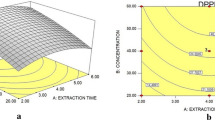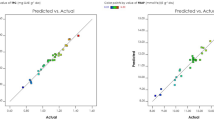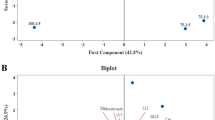Abstract
There is growing interest in measuring the antioxidant status of plant tissues. This protocol describes the oxygen radical absorbance capacity (ORAC) assay, which measures antioxidant inhibition of peroxyl radical–induced oxidations and is a measure of total antioxidant capacity. The assay is performed in a microplate and is assessed with a 96-well multi-detection plate reader. Total antioxidant capacity of 64 experimental samples can easily be analyzed in 1 d. This assay is presented along with rapid assays for total phenolic content and total ascorbate content. Overall, these assays provide a general diagnostic tool of the antioxidant capacity in leaf tissue extracts.
This is a preview of subscription content, access via your institution
Access options
Subscribe to this journal
Receive 12 print issues and online access
$259.00 per year
only $21.58 per issue
Buy this article
- Purchase on SpringerLink
- Instant access to full article PDF
Prices may be subject to local taxes which are calculated during checkout


Similar content being viewed by others
References
Asada, K. & Takehashi, M. Production and scavenging of active oxygen in photosynthesis. In Photoinhibition (eds. Kyle, D.J., Osmond, C.B. & Arntzen, C.J.) 227–287 (Elsevier, Amsterdam, The Netherlands, 1987).
Finkel, T. & Holbrook, N.J. Oxidants, oxidative stress and the biology of aging. Nature 408, 239–247 (2000).
Bolwell, G.P. et al. The apoplastic oxidative burst in response to biotic stress in plants: a three-component system. J. Exp. Bot. 53, 1367–1376 (2002).
Mittler, R. Oxidative stress, antioxidants and stress tolerance. Trends Plant Sci. 7, 405–410 (2002).
Neill, S., Desikan, R. & Hancock, J. Hydrogen peroxide signaling. Curr. Opin. Plant Biol. 5, 388–395 (2002).
Polle, A. Dissecting the superoxide dismutase-ascorbate-glutathione-pathway in chloroplasts by metabolic modeling. Computer simulations as a step towards flux analysis. Plant Physiol. 126, 445–462 (2001).
Carol, R.J. & Dolam, L. The role of reactive oxygen species in cell growth: lessons from root hairs. J. Exp. Bot. 57, 1829–1834 (2006).
Pei, Z.M. et al. Calcium channels activated by hydrogen peroxide mediate abscisic acid signaling in guard cells. Nature 406, 731–734 (2000).
De Gara, L., de Pinto, M.C. & Tommasi, F. The antioxidant systems vis-a-vis reactive oxygen species during plant–pathogen interaction. Plant Physiol. Biochem. 41, 863–870 (2003).
Desikan, R., A-H-Mackerness,, S., Hancock, J.T. & Neill, S.J. Regulation of the Arabidopsis transcriptome by oxidative stress. Plant Physiol. 127, 159–172 (2001).
Noctor, G. & Foyer, C.H. Ascorbate and glutathione: keeping active oxygen under control. Annu. Rev. Plant Physiol. Plant Mol. Biol. 49, 249–279 (1998).
Dat, J. et al. Dual action of the active oxygen species during plant stress responses. Cell. Mol. Life Sci. 57, 779–795 (2000).
Desikan, R., Hancock, J. & Neill, S. Reactive oxygen species as signaling molecules. In Antioxidants and Reactive Oxygen Species in Plants (ed. Smirnoff, N.) 169–196 (Blackwell Publishing, Oxford, UK, 2005).
Larson, R.A. The antioxidants of higher plants. Phytochem. 27, 969–978 (1988).
Ghisseli, A., Serafini, M., Natella, F. & Scaccini, C. Total antioxidant capacity as a tool to assess redox status: critical view and experimental data. Free Radic. Biol. Med. 29, 1106–1114 (2000).
Blokhina, O., Virolainen, E. & Fagerstedt, K.V. Antioxidants, oxidative damage and oxygen deprivation stress: a review. Ann. Bot.(Lond) 91, 179–194 (2003).
Huang, M. & Guo, Z. Responses of antioxidative system to chilling stress in two rice cultivars differing in sensitivity. Biol. Plant. 49, 81–84 (2005).
Nayyar, H. & Gupta, D. Differential sensitivity of C3 and C4 plants to water deficit stress: association with oxidative stress and antioxidants. Environ. Exp. Bot. 58, 106–113 (2006).
Scebba, F., Pucciarelli, I., Soldatini, G.F. & Ranieri, A. O3-induced changes in the antioxidant systems and their relationship to different degrees of susceptibility of two clover species. Plant Sci. 165, 583–593 (2003).
Huang, D., Ou, B., Hampsch-Woodill, M., Flanagan, J.A. & Prior, R.L. High throughput assay of oxygen radical absorbance capacity (ORAC) using a multichannel liquid handling system coupled with a microplate fluorescence reader in 96-well format. J. Agric. Food Chem. 50, 4437–4444 (2002).
Cao, G. & Prior, R.L. Measurement of oxygen radical absorbance capacity in biological samples. Methods Enzymol. 299, 50–62 (1999).
Ghisseli, A., Serafini, M., Maiani, G., Assini, E. & Ferro-Luzzi, A. A fluorescence-based method for measuring total plasma antioxidant capability. Free Radic. Biol. Med. 18, 29–36 (1995).
Glazer, A.N. Phycoerythrin fluorescence-based assay for reactive oxygen species. Methods Enzymol. 186, 161–168 (1990).
Miller, N.J., Rice-Evans, C., Davies, M.J., Gopinathan, V. & Milner, A. A novel method for measuring antioxidant capacity and its application to monitoring the antioxidant status in premature neonates. Clin. Sci. (Lond) 84, 407–412 (1993).
Wayner, D.D., Burton, G.W., Ingold, K.U. & Locke, S. Quantitative measurement of the total, peroxyl radical-trapping antioxidant capability of human blood plasma by controlled peroxidation. The important contribution made by plasma proteins. FEBS Lett. 187, 33–37 (1985).
Prior, R.L., Wu, X. & Schaich, K. Standardized methods for the determination of antioxidant capacity and phenolics in foods and dietary supplements. J. Agric. Food Chem. 53, 4290–4302 (2005).
Ainsworth, E.A. & Gillespie, K.M. Estimation of total phenolic content and other oxidation substrates in plant tissues using Folin-Ciocalteu reagent. Nat. Protoc. 2, 875–877 (2007). doi: 10.1038/nprot.2007.102 (2007).
Gillespie, K.M. & Ainsworth, E.A. Measurement of reduced, oxidized and total ascorbate content in plants. Nat. Protoc. 2, 871–874 (2007). doi: 10.1038/nprot.2007.101 (2007).
Grace, S.C. Phenolics as antioxidants. In Antioxidants and Reactive Oxygen Species in Plants (ed. Smirnoff, N.) 141–168 (Blackwell Publishing, Oxford, UK, 2005).
Acknowledgements
This research was supported by the Office of Science (BER), U.S. Department of Energy, Grant no. DE-FG02-04ER63849.
Author information
Authors and Affiliations
Corresponding author
Ethics declarations
Competing interests
The authors declare no competing financial interests.
Rights and permissions
About this article
Cite this article
Gillespie, K., Chae, J. & Ainsworth, E. Rapid measurement of total antioxidant capacity in plants. Nat Protoc 2, 867–870 (2007). https://doi.org/10.1038/nprot.2007.100
Published:
Issue date:
DOI: https://doi.org/10.1038/nprot.2007.100
This article is cited by
-
Long-Term Effects of Cold Atmospheric Plasma-Treated Water on the Antioxidative System of Hordeum vulgare
Journal of Plant Growth Regulation (2023)
-
Physiological and morphological effects of a marine heatwave on the seagrass Cymodocea nodosa
Scientific Reports (2022)
-
Beneficial effects of gamma-irradiation of quinoa seeds on germination and growth
Radiation and Environmental Biophysics (2022)
-
Characterization of alginate extracted from Sargassum latifolium and its use in Chlorella vulgaris growth promotion and riboflavin drug delivery
Scientific Reports (2021)
-
Thiourea and hydrogen peroxide priming improved K+ retention and source-sink relationship for mitigating salt stress in rice
Scientific Reports (2021)




Katharine Barnes
Comment uploaded on behalf of:
Elena Mellado-Ortega; Inigo Zabalgogeazcoa; Beatriz R. Vazquez de Aldana; Juan B. Arellano
Departamento de Estres Abiotico. Instituto de Recursos Naturales y Agrobiologia de Salamanca (IRNASA-CSIC). Cordel de merinas 52, 37008 Salamanca. Spain
Gillespie and co-workers describe in their protocol how to measure the total antioxidant capacity (TAC) of plant tissues using the oxygen radical absorbance capacity (ORAC) method in 96-well multi-detection plate readers. ORAC is a hydrogen atom transfer based assay, widely recognized as the most common choice among its rivals to quantify the peroxyl radical scavenging capacity of a sample in vitro. Despite the advantages of ORAC over other TAC methods, several reports have outlined limitations and pitfalls in ORAC that should be borne in mind in its execution [refs 1-4].
In line with the above reports, Gillespie and co-workers include a list of cautions and critical steps in their protocol, most of them related to the handling of samples and the high variability in antioxidant capacity in leaf tissue or among blanks and/or standards. In particular, they specify that the kinetic reads of the ORAC assay must begin immediately after the addition of 25 micro L of the peroxyl radical initiator 2,2- Azobis(2-methylpropionamidine) dihydrochloride (AAPH) to avoid variability of TAC values among samples and they suggest the use of a multi-channel pipette to improve results. AAPH addition cannot be performed simultaneously in all the 96 wells and, in fact, it takes approximately 90-150 s to dispense it carefully in all of them, even if a well-experienced lab analyst uses a multi-channel pipette or the multi-detection plate reader includes an automatic injector. In our laboratory, we noticed that the time delay in the addition of AAPH between wells really mattered and was responsible for a systematic error in our analyses that certainly we could not ignore. The Figure below shows a representative plot of individual corrections factors that we had to apply to the TAC value of a sample in a particular well to match the mean TAC value of all the 72 wells where an equal volume of the same sample was loaded. That is, the same sample had different TAC values, just simply depending on its position in the 96-well plate. Because of this, the TAC values for a sample could then be underestimated or overestimated by about 5-20% in ORAC assays.
Our remark on this step of the ORAC protocol by Gillespie and co-workers has the sole intention to raise awareness of this source of error among ORAC users, and to find a solution when AAPH cannot be added simultaneously in the 96 wells of the microplate. Two alternative solutions were presented in our recent study on ORAC [ref 5]. In brief, one solution is to create a correction factor for each of 96 wells of the microplate using a Trolox standard solution of known concentration. In this case, the correction factor of each well must be taken into account to correct the experimentally-determined TAC values for trial samples under analysis. Alternatively, technical replicates of trial samples can be distributed symmetrically through the 96-well plate to compensate early and late kinetic reads in the 96-well plates. In this latter case, the determination of a correction factor for each well is not required.
See figure at:
<img src="http://blogs.nature.com/ste..." alt="Comment image" style="width:410px;height:330px;">
Figure legend. Correction factor values applied to each of the 96 wells of a microplate to correct the underestimated/overestimated values of the ORAC activity of 25 micro L of a sample containing 75 micro M Trolox. The ORAC assay was carried out with the stock solutions of 0.08 micro M fluorescein, 125 mM AAPH and 75 micro M Trolox in 75 mM sodium phosphate pH 7.0. Inset: wells of the 96-well microplate are numbered following a horizontal zig-zag pattern from A1 (well number 1); to H1 (well number 96);. Lanes D and E (wells from 37 to 60); were reserved for the blank and Trolox standard solutions. Further details are described by Mellado-Ortega and co-workers [ref.5].
*References*
1	Schaich, K. M., Tian, X. & Xie, J. Hurdles and pitfalls in measuring antioxidant efficacy: A critical evaluation of ABTS, DPPH, and ORAC assays. Journal of Functional Foods 14, 111-125, (2015).
2	Prior, R. L. et al. Assays for hydrophilic and lipophilic antioxidant capacity (oxygen radical absorbance capacity (ORACFL)) of plasma and other biological and food samples. J. Agric. Food. Chem. 51, 3273-3279, (2003).
3	Watanabe, J. et al. Method validation by interlaboratory studies of improved hydrophilic oxygen radical absorbance capacity methods for the determination of antioxidant capacities of antioxidant solutions and food extracts. Anal. Sci. 28, 159-165 (2012).
4	Dorta, E. et al. The ORAC (oxygen radical absorbance capacity) index does not reflect the capacity of antioxidants to trap peroxyl radicals. RSC Advances 5, 39899-39902, (2015).
5	Mellado-Ortega, E., Zabalgogeazcoa, I., Vazquez de Aldana, B. R. & Arellano, J. B. Solutions to decrease a systematic error related to AAPH addition in the fluorescence-based ORAC assay. Anal. Biochem. 519, 27-29, (2017).